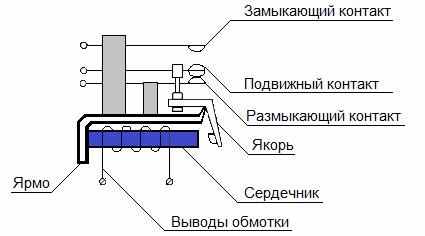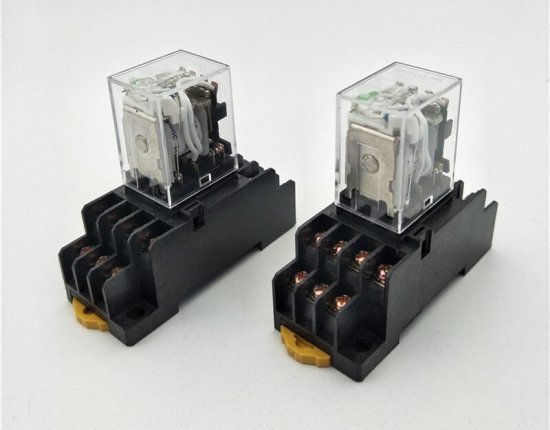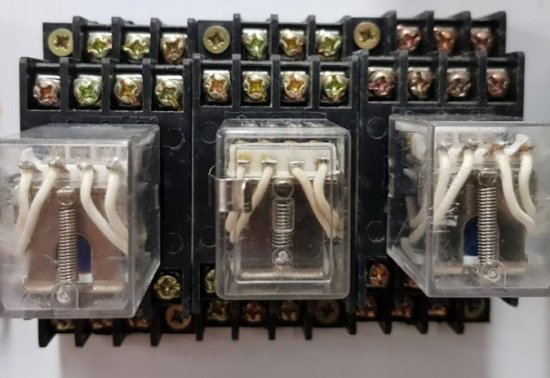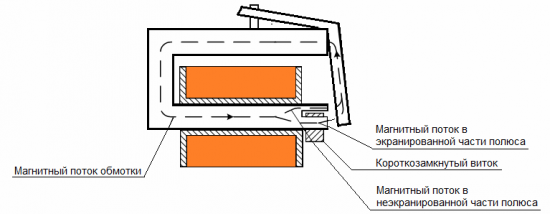DC and AC relays — characteristics and differences
In the broadest sense of the word, a relay is understood as an electronic or electromechanical device whose purpose is to close or open an electrical circuit in response to a specific input action. Classic relay — electromagnetic.
When the current passes through the coil of such a relay, a magnetic field arises, which, acting on the ferromagnetic armature of the relay, causes the movement of this armature, while it, mechanically connected to the contacts, closes or opens them as a result of its movement. Thus, with the help of a relay, you can make closing or opening, that is, mechanical switching of external electrical circuits.
An electromagnetic relay consists of at least three (main) parts: a stationary electromagnet, a movable armature and a switch. An electromagnet is essentially a coil wound with copper wire around a ferromagnetic core. The role of the armature is usually a plate made of magnetic metal which is designed to act on the switching contacts or on a group of such contacts which actually form the relay.
To this day, electromagnetic relays are widely used in automation devices, telemechanics, electronics, computer technology and in many other areas where automatic switching is required. In practice, the relay is used as a controlled mechanical switch or switch. Special relays called contactors are used to switch large currents.
In all this, electromagnetic relays are divided into DC relays and AC relays, depending on what current must be applied to the relay coil to operate its switch. Next, let's look at the differences between a DC relay and an AC relay.
DC electromagnetic relay
When talking about a direct current relay, as a rule, they mean a neutral (non-polarized) relay that responds equally to current in each direction in its winding - the armature is attracted to the core, opening (or closing) the contacts. In terms of armature construction, the relays are available with a retractable armature or with a rotating armature, but in any case, functionally, these products are completely similar.
As long as there is no current flowing in the relay coil, its armature is located as far as possible from the core due to the action of the return spring. In this state, the relay contacts are open (for a normally open relay or for a normally open contact group of that relay) or closed (for a normally closed relay or for a normally closed contact group).

When direct current flows through the relay coil, a magnetic flux is created in the core and in the air gap between the relay core and armature, initiating a magnetic force that mechanically attracts the armature to the core.
The armature moves, transferring the contacts to a state opposite to the initial one—closing the contacts if they were initially open, or opening them if the initial state of the contacts was closed.
If the relay contains two sets of contacts with opposite initial states, then those that were closed open and those that were open close. This is how a DC relay works.
Electromagnetic relay for alternating current
In some cases, that's all that happens alternating current… Then nothing remains but to use an alternating current switching relay, that is, a relay whose coil is capable of acting on the armature when alternating current rather than direct current flows through it.
Unlike a DC relay, an AC relay of the same dimensions and with the same average magnetic induction in its core provides half the magnetic force on the armature as a DC relay.
The conclusion is that the electromagnetic force, in the case of alternating current, if applied to the coil of a conventional relay, would have a pronounced pulsating character and would turn to zero twice during the period of oscillation of the alternating supply voltage.
This means that the anchor will experience vibrations. But this would happen if additional measures were not taken. Additional measures are also applied, which only form the differences in the construction of AC and DC relays.
An AC relay is arranged and operates as follows. The alternating magnetic flux of the main winding passing through the slotted core portion is divided into two parts.One part of the magnetic flux passes through the shielded part of the split pole (through the one on which the short-circuited conducting turn is mounted), while the other part of the magnetic flux is directed through the unshielded part of the split pole.
Since an EMF and, accordingly, a current is induced in a short circuit, the magnetic flux of a given loop (current induced in it) opposes the magnetic flux that causes it, which leads to the fact that the magnetic flux in a part of the core with a loop lags behind the flux in the part of the core without contour 60-80 degrees.
As a result, the total drag force on the armature never vanishes because both fluxes cross zero at different times and no significant vibrations occur in the armature. The resulting force on the armature thus formed is capable of causing a commutating action.



